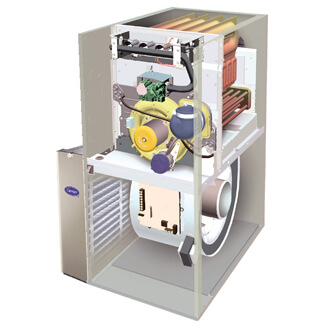What Is A Heat Pump?
A heat pump transfers thermal energy from one environment to another. In a heating and cooling unit, the heat pump moves heat from the outside to the indoors in colder months, and moves heat outside in warmer months.
How Does a Heat Pump Work?
During summer months, a heat pump acts as an air conditioner. When the weather is warm, it extracts heat from inside your home and moves it outside. In the colder winter months, a heat pump takes heat from the outside air and moves inside the home.
That last sentence may sound confusing at first. How can cold air produce heat?
Even cold air contains some heat energy. What the heat pump does in colder months is extract the heat energy from the outside air and move it inside your home. In certain climates, the heat pump is used in conjunction with a gas furnace to improve energy efficiency.
If there is not enough heat in the outside air to warm the home to the thermostat setting, the gas furnace kicks on.
During hot summer months, a heat pump works similarly to an air conditioner. Heat energy is transferred from the inside of your home to the outside environment.
The Inner Workings of a Heat Pump
Heat pumps transfer thermal energy by circulating refrigerant through a cycle of evaporation and condensation. There are two units, outdoor and indoor, and each has a coil and fan. Depending on whether the heat pump is operating in heating or cooling mode, one of the coil/fan units will act as a condenser, and the other will act as an evaporator.
During both heating and cooling cycles, a compressor pumps the refrigerant between the two heat exchange coils. In the evaporator coil, the refrigerant is evaporated at a low pressure, and it absorbs the heat from its environment. The refrigerant is then sent to the condenser coil, where the refrigerant condenses at high pressure. The heat that was absorbed from the other coil is released into the other environment.
In cooling mode, the inside coil acts as an evaporator, and the outside coil is the condenser. The fan on the outside unit helps disperse the heat from inside the home to the outside air.
During the heating cycle, the outside coil is the evaporator, and the inside coil is the condenser. The fan on the inside unit blows the heat collected from the outside air through the ductwork in the house.
Heat Pump vs Air Conditioner: What’s the Difference?
Air conditioners use the same type of technology to cool your home and have similar energy efficiency. Aside from a few minor technical details, the biggest difference is that a heat pump can both heat and cool your home. An air conditioner must be paired with a furnace in order to heat your home.
Because of the way heat pumps work, they function most efficiently in moderate climates.

Heat Pumps vs. Gas Furnaces: How Are They Different?
The biggest difference between a heat pump and a furnace is the way that they create heat. Heat pumps use electricity to transfer heat between two environments. A furnace burns natural gas or heating oil to create heat.
Heat pumps are more efficient, as they use thermal energy in the air to produce heat. Another difference is heat pumps do not create any emissions that contribute to climate change.
In Mediterranean climates, a heat pump takes the place of an air conditioner, producing heat or removing heat, as the seasons change.
What Types of Heat Pumps are There?
The main types of heat pumps are air source and geothermal.
Air source heat pumps transfer heat from the air. Geothermal heat pumps draw heat from the ground or a nearby water source.
Is a Heat Pump the Right Choice for Me?
Our team of HVAC specialists can help you figure out what the best solution is for your heating and cooling needs. For a free estimate, you can fill out the form here or call Ventwerx at (408) 422-2987 in San Jose or (408) 710-9595 in Morgan Hill.